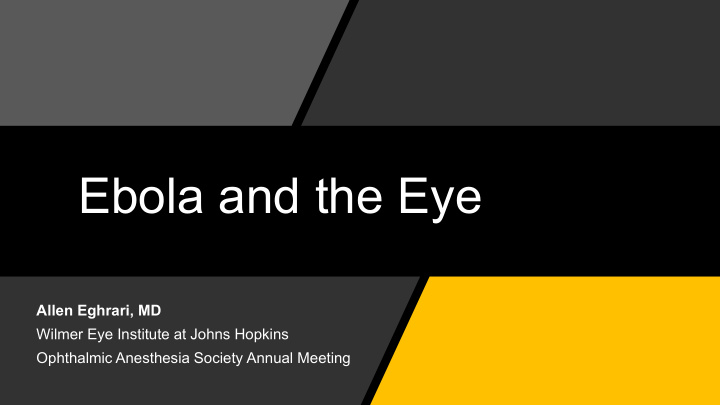



Ebola and the Eye Allen Eghrari, MD Wilmer Eye Institute at Johns Hopkins Ophthalmic Anesthesia Society Annual Meeting
CDC/Cynthia Goldsmith
A high case fatality rate • <21 years old: 57% • >45 years old: 94%
28,555 affected 11,311 deaths
Credit: Liam Sharp
Early reports of survivor complaints An urgent need for knowledge and intervention Survivors Conference in Kenema, late 2014 http://www.who.int/features/2014/post-ebola-syndrome/en/
Eye sub-study objectives • Explore causes of decreased vision and other ocular problems reported by EVD survivors • Relate the timing of ocular complaints to disease course and other systemic problems • Classify the ocular pathology present in EVD survivors, and define the nature of associated ocular inflammation • Facilitate treatment for EVD-associated vision loss • Follow patients longitudinally for up to 5 years
Our clinic
Training • Practice with equipment Didactics on eye topics • • Monitoring and real-time feedback
Training
Training
Posterior synechiae
Lens Inflammatory anterior subcapsular plaque Posterior subcapsular cataract
Vitreous Cell Vitreous cells Clear vitreous with early PVD OD OS 2+ AC cell, 1+ vit cell, 1+ haze ERM, minimal CME, no vitreous cell
Focal retinal lesions Focal lesion Disruption of outer retina
Intraretinal fluid
Research in Liberia
History of Ophthalmology Clinical Research in Liberia • Infectious Diseases • Onchocerciasis • Cataract surgery in leprosy Am J Trop Med Hyg. 1963 Sep;12:761-6 • Case reports of Liberians abroad • West African Crystalline Maculopathy • Tuberculosis conjunctivitis
Prevail 7 Clinical Trial • Is it safe to do surgery in eyes of Ebola survivors? • Can the virus persist in the central nervous system?
Surgery, Anesthesia, and Ebola • Risks to anesthesiologist • Risks to patient • Risks to surgeon • Risks to staff
Recommend
More recommend